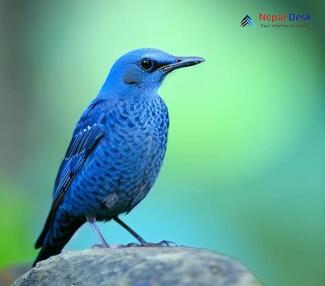Nestled amidst the breathtaking landscapes of the Himalayas, Nepal is a haven for bird enthusiasts seeking out the country's diverse and magnificent avian species. One such captivating bird is the Blue Rock Thrush (Monticola solitarius), found in various parts of Nepal. The Blue Rock Thrush is a medium-sized songbird belonging to the family Muscicapidae. The thrush is known for its distinctive appearance and melodious call. These charismatic birds embody beauty and allure against Nepal's breathtaking mountain landscape. In this article, we will delve into the intriguing world of the Blue Rock Thrush, exploring its appearance, habitat, and behaviors.
A Striking Appearance
The Blue Rock Thrush is known for its striking appearance, displaying a mix of blue and gray colors that set it apart from other birds. Males are predominantly blue, with an impressive dark-blue head and neck, chestnut belly patches, and grayish-blue wings and tail. Meanwhile, females exhibit a more muted color palette with gray-brown plumage and subtle patches of blue.
Thriving in Nepalese Habitats
Though not endemic to Nepal, the Blue Rock Thrush has found a comfortable home within the rugged terrain of this beautiful country. They can be spotted in various regions, from subtropical forests to rocky slopes within national parks like Bardia and Chitwan. These adaptable birds are known to favor cliffs and rock faces, often perching on high vantage points overlooking their surroundings.
A Solitary Lifestyle
True to its name, the Blue Rock Thrush leads a primarily solitary existence. These birds are often seen perched alone on rocky outcrops or quietly foraging for insects among boulders. During breeding seasons, they become more vocal, with males showcasing their melodious songs to attract mates.
Adaptable Foraging Strategies
The Blue Rock Thrush feeds mainly on insects such as beetles, ants, grasshoppers, and larvae; however, it also supplements its diet with fruits and small vertebrates when needed. This versatile bird generally forages on the ground, hopping gracefully from stone to stone in search of its next meal.
Leaving a Lasting Impression
The Blue Rock Thrush's stunning appearance and unique lifestyle have made it a sought-after sighting for birdwatchers venturing into Nepal's picturesque environment. The presence of this enigmatic creature adds another layer of intrigue to the allure of Nepal's rich biodiversity. So, whether you're an avid birder or simply appreciate the wonders of the natural world, keep an eye out for the enchanting Blue Rock Thrush during your next trip to Nepal.




